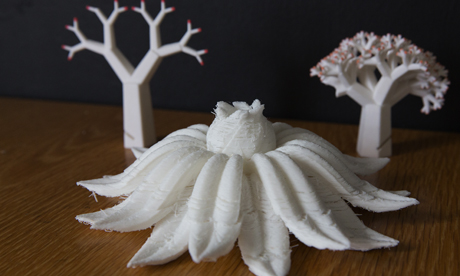Sci-fi-like and revolutionary, 3D printing is now available in Hackney

Pretty, yes, but are they of any use?: objects created using a 3D printer. Photograph: Eleonore de Bonneval
Imagine being able recreate almost any object out of plastic, or a limited range of metals, and all in your own home.
Welcome to the sci-fi-like world of 3D printing, also known as additive manufacturing, which creates three dimentional models from digital files layer by layer, as distinct from subtractive manufacturing which carves out objects from a block of material.
‘3D printing’ is an umbrella term covering a range of different technologies achieving similar results through additive methods.
The technology is becoming increasingly popular; in July SPACE Studios launched a kickstarter campaign to open an affordable 3D printing lab.
The most common method for the home involves ‘extrusion deposition’ in which a coil of plastic or metal is fed in and melted into something like a glue gun attached to a frame that can move both horizontally and vertically.
Imagine your bubble jet printer with its side-to-side strafing movement, but now it also goes forwards and backwards and (and this is the important part) up and down.
Now imagine the paper as a cross section of a 3D object and you have grasped the basic concept.
Another widespread method fuses a liquid gel or fine granules of a base material such as plastic or metal filings into a solid using a laser.
The digital aspect of 3D printing allows us to do a few new things and a few old things more conveniently.
Each 3D printed object is born on a computer.
The ability to print on demand could allow manufacturers to hold digital inventories rather than physical ones.
It would also be possible to easily build exact replicas of objects on different scales or warp an object according to one’s own designs.
You could scan a kid’s toy and completely customise it, for example.
3D printing also allows for ‘mass customisation’ – the ability for each person to customise their own branded goods.
According to Paul Smyth, an engineer and partner at Dalston-based design firm Something & Son, the one unique thing that can be done using 3D printing and in no other way involves the creation of objects within objects.
For example, you could make a sculpture of a person with the internal organs inside.
As interesting as this is, the real question 3D printing raises is, what will it change? Artists and technologists have warmly embraced it, but that hasn’t made them any clearer on the revolutionary use to which the technology might ultimately be put.
“What do you use a 3D printer for?” asks enthusiast Ian Lewis at London Hackspace, a community workshop where people share their knowledge and tools for technology-related projects.
“I printed a little heart for my girlfriend,” he adds. “That’s pretty much it.”
There are more questions. What effect will printing with plastic have on landfill and the environment?
Will we enter the realm of piracy of physical objects similar to the piracy of music through audio files?
Will there be security risks with people having the ability to print guns in their own homes (true, not particularly good guns, but what of the challenge of detecting a plastic gun at the airport)?
One question is settled, 3D printing (for now) is more expensive than mass production.
“If I need a plug for the sink, by the time I’ve designed it and printed it, I could’ve walked up to the pound shop to buy four,” says Lewis.
At the moment, it seems the main outputs of 3D printing are its contribution to the cultural shift towards doing things yourself and a promise to lead to something quite amazing in the future and we might already know what this is.
The newly acquired ability to print working human organs (kidneys and livers, only in miniature at the moment) has quite clear applications and has the whiff of a revolutionary idea about it.
